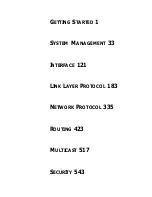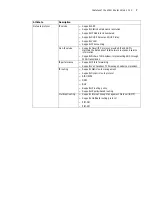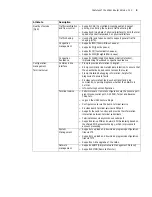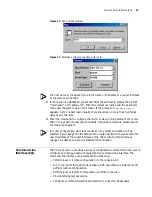
10
C
HAPTER
1: 3C
OM
R
OUTER
I
NTRODUCTION
New Features of the
3Com Router 1.x
New features have been added to the 3Com Router1.10.
Support New Interfaces
E3 and CE3 Interfaces
Both E3 and E1 are part of the ITU-T digital carrier architecture and are used in
most regions beyond North America. The data transmission speed of E3 is
34.368 Mbps and the line code is HDB3. E3/CE3 interfaces support the link layer
protocols including PPP, HDLC, Frame Relay, LAPB, and X.25, as well as the
network protocol such as IP. Similar to E1/CE1, E3/CE3 interfaces can work in two
operating modes, namely, E3 mode and CE3 mode.
■
When working in E3 mode, an E3/CE3 interface is a timeslot-less interface of
the bandwidth of 34.368 Mbps.
■
When working in CE3 mode, it can multiplex/demultiplex 16 channels of E1
signals. The E3-to-E1 multiplexing is compliant with the G.751 and G.742
provisions of ITU-T. In addition, each E1 interface can be divided into 32
timeslots.
E1-F/T1-F Interface
E1-F and T1-F interfaces refer to the fractional E1 and T1 interfaces, which are
equivalent to the simplified CE1/PRI and CT1/PRI interfaces. In essence, they are a
low-cost approach to E1/T1 access. In a simple E1 or T1 access application
requiring neither division of multiple channel groups nor ISDN PRI, either the E1-F
or T1/F interface will be a good choice.
Null Interface
The functions of the Null interface are similar to those of null devices supported by
many operating systems. It is always in UP status, but cannot forward data packets
or configure IP addresses or encapsulate other protocols. Null interface is a virtual
interface with software characteristics. Any network data packet sent to this
interface will be dropped.
FRoIP and FRoISDN
Frame Relay over IP
As IP networks have gained wider acceptance, Frame Relay (FR) applications have
relied on IP networks for data communication and interconnection between
networks. FRoIP technology enables IP networks to carry FR data by establishing a
GRE tunnel across the IP network to connect the two FR networks at both ends of
the IP network.
Frame Relay over ISDN
Frame Relay over ISDN provides a method for accessing the Frame Relay network
based on ISDNs and the related devices. This shortens the time for users to access
and lowers the cost of leased lines.
The Frame Relay over ISDN is mainly used in the following two aspects:
■
The simplest application is to take Frame Relay over ISDN as the main
communications method. That is, all the routers support Frame Relay over
ISDN, and the individual routers can directly access the Frame Relay networks
(without TA adapters) to communicate.
Summary of Contents for 3036
Page 1: ...http www 3com com 3Com Router Configuration Guide Published March 2004 Part No 10014299 ...
Page 4: ...VPN 615 RELIABILITY 665 QOS 681 DIAL UP 721 ...
Page 6: ...2 ABOUT THIS GUIDE ...
Page 7: ...I GETTING STARTED Chapter 1 3Com Router Introduction Chapter 2 3Com Router User Interface ...
Page 8: ...4 ...
Page 16: ...12 CHAPTER 1 3COM ROUTER INTRODUCTION ...
Page 34: ...30 ...
Page 60: ...56 CHAPTER 3 SYSTEM MANAGEMENT ...
Page 98: ...94 CHAPTER 6 DISPLAY AND DEBUGGING TOOLS ...
Page 110: ...106 ...
Page 114: ...110 CHAPTER 8 INTERFACE CONFIGURATION OVERVIEW ...
Page 158: ...154 CHAPTER 10 CONFIGURING WAN INTERFACE ...
Page 168: ...164 ...
Page 188: ...184 CHAPTER 13 CONFIGURING PPPOE CLIENT ...
Page 192: ...188 CHAPTER 14 CONFIGURING SLIP Router ip route static 0 0 0 0 0 0 0 0 10 110 0 1 ...
Page 248: ...244 CHAPTER 16 CONFIGURING LAPB AND X 25 ...
Page 320: ...316 ...
Page 330: ...326 CHAPTER 20 CONFIGURING IP ADDRESS ...
Page 362: ...358 CHAPTER 21 CONFIGURING IP APPLICATION ...
Page 374: ...370 CHAPTER 23 CONFIGURING IP COUNT ...
Page 406: ...402 CHAPTER 25 CONFIGURING DLSW ...
Page 408: ...404 ...
Page 452: ...448 CHAPTER 29 CONFIGURING OSPF ...
Page 482: ...478 CHAPTER 30 CONFIGURING BGP ...
Page 494: ...490 CHAPTER 31 CONFIGURING IP ROUTING POLICY ...
Page 502: ...498 ...
Page 508: ...504 CHAPTER 33 IP MULTICAST ...
Page 514: ...510 CHAPTER 34 CONFIGURING IGMP ...
Page 526: ...522 CHAPTER 36 CONFIGURING PIM SM ...
Page 528: ...524 ...
Page 532: ...528 CHAPTER 37 CONFIGURING TERMINAL ACCESS SECURITY ...
Page 550: ...546 CHAPTER 38 CONFIGURING AAA AND RADIUS PROTOCOL ...
Page 590: ...586 CHAPTER 40 CONFIGURING IPSEC ...
Page 599: ...IX VPN Chapter 42 Configuring VPN Chapter 43 Configuring L2TP Chapter 44 Configuring GRE ...
Page 600: ...596 ...
Page 638: ...634 CHAPTER 43 CONFIGURING L2TP ...
Page 649: ...X RELIABILITY Chapter 45 Configuring a Standby Center Chapter 46 Configuring VRRP ...
Page 650: ...646 ...
Page 666: ...662 ...
Page 670: ...666 CHAPTER 47 QOS OVERVIEW ...
Page 700: ...696 CHAPTER 49 CONGESTION MANAGEMENT ...
Page 706: ...702 CHAPTER 50 CONGESTION AVOIDANCE ...
Page 707: ...XII DIAL UP Chapter 51 Configuring DCC Chapter 52 Configuring Modem ...
Page 708: ...704 ...
Page 762: ...758 CHAPTER 52 CONFIGURING MODEM ...















































